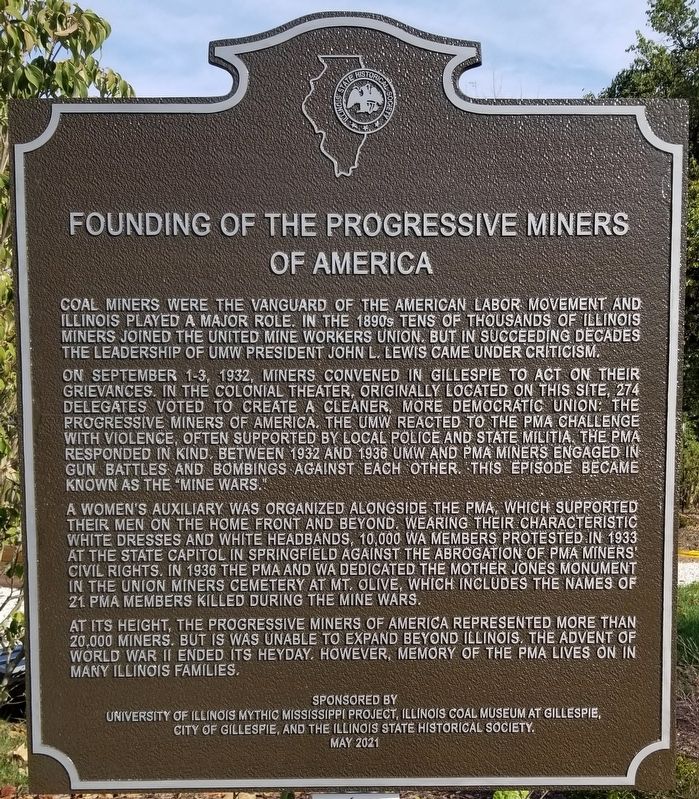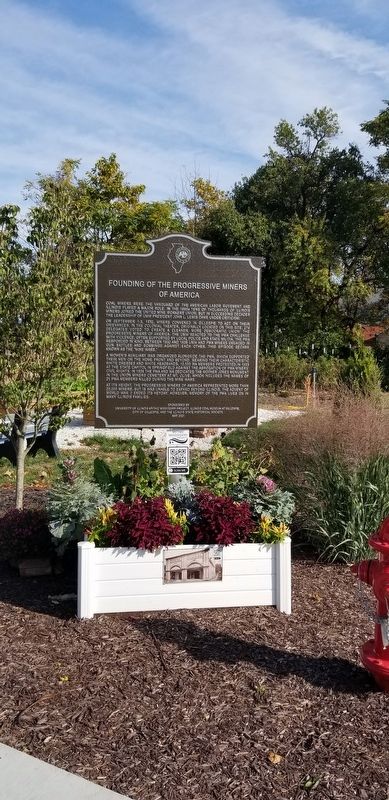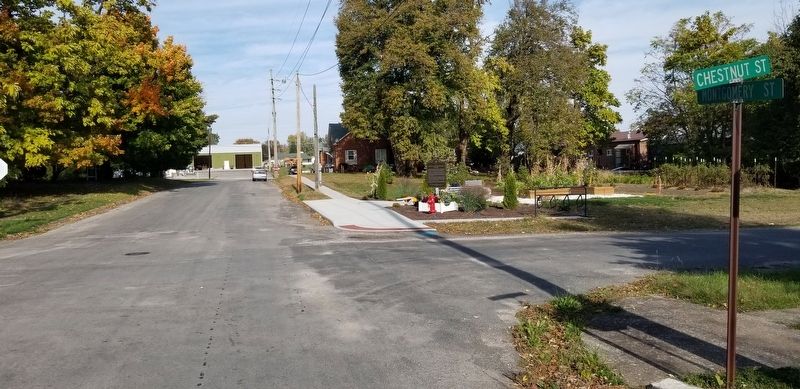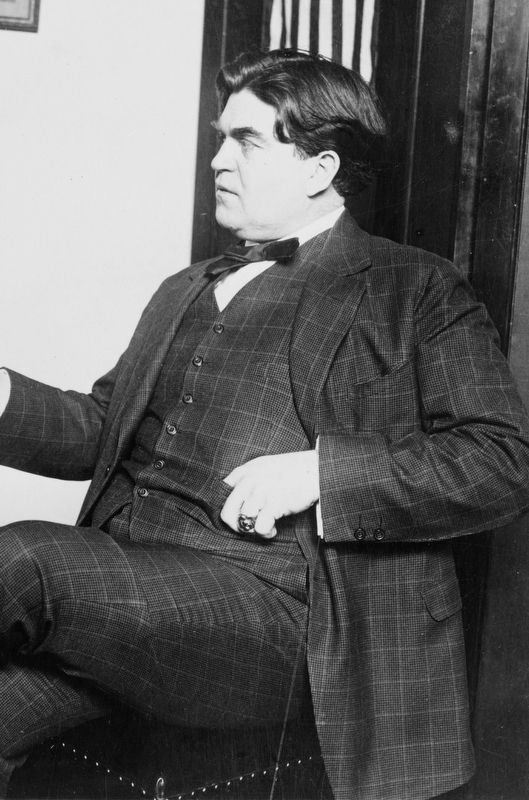Gillespie in Macoupin County, Illinois — The American Midwest (Great Lakes)
Founding of the Progressive Miners of America
Inscription.
Coal miners were the vanguard of the American Labor Movement and Illinois played a major role. In the 1890s tens of thousands of Illinois miners joined the United Mine Workers Union. But in succeeding decades the leadership of UMW President John L. Lewis came under criticism.
On September 1-3, 1932, miners convened in Gillespie to act on their grievances. In the Colonial Theater, originally located on this site, 274 delegates voted to create a cleaner, more democratic union: the Progressive Miners of America. The UMW reacted to the PMA challenge with violence, often supported by local police and state militia. The PMA responded in kind. Between 1932 and 1936 UMW and PMA miners engaged in gun battles and bombings against each other. This episode became known as the "Mine Wars".
A Women's Auxiliary was organized alongside the PMA, which supported their men on the home front and beyond. Wearing their characteristic white dresses and white headbands, 10,000 WA members protested in 1933 at the state capitol in Springfield against the abrogation of PMA Miners' Civil Rights. In 1938 the PMA and WA dedicated the Mother Jones Monument in the Union Miners Cemetery at Mt. Olive, which includes the names of 21 PMA members killed during the Mine Wars.
At its height, the Progressive Miners of America represented more than 20,000 miners. But is was unable to expand beyond Illinois. The advent of World War II ended its heyday. However, memory of the PMA lives on in many Illinois families.
Erected 2021 by University of Illinois Mythic Mississippi Project, Illinois Coal Museum at Gillespie, City of Gillespie, and the Illinois State Historical Society.
Topics and series. This historical marker is listed in these topic lists: Industry & Commerce • Labor Unions • Women. In addition, it is included in the Illinois State Historical Society series list. A significant historical year for this entry is 1932.
Location. 39° 7.642′ N, 89° 48.915′ W. Marker is in Gillespie, Illinois, in Macoupin County. Marker is at the intersection of Montgomery Street and East Chestnut Street, on the right when traveling north on Montgomery Street. The marker is located in front of a small park at the intersection. Touch for map. Marker is at or near this postal address: 201 Montgomery Street, Gillespie IL 62033, United States of America. Touch for directions.
Other nearby markers. At least 8 other markers are within 9 miles of this marker, measured as the crow flies. Macoupin & Chestnut Streets (about 400 feet away, measured in a direct line); Dedicated to the Soldiers and Sailors of Gillespie (about 600 feet away); Veterans Memorial (about 600 feet away); Heart of Coal Country (about 700 feet
away); Union Miners Cemetery at Mt. Olive, Illinois (approx. 5˝ miles away); Soulsby Shell Station, Mt. Olive, Illinois (approx. 5.8 miles away); Ill. Traction System (approx. 8.1 miles away); a different marker also named Veterans Memorial (approx. 8.1 miles away). Touch for a list and map of all markers in Gillespie.
Also see . . .
1. Progressive Miners of America.
The Progressive Miners of America (PMA, renamed the Progressive Mine Workers of America, PMWA, in 1938) was a coal miners' union organized in 1932 in downstate Illinois. It was formed in response to a 1932 contract proposal negotiated by United Mine Workers President John L. Lewis, which reduced wages from a previous rate of $6.10 per day to $5.00 per day. Source: Wikipedia(Submitted on October 28, 2021, by James Hulse of Medina, Texas.)
2. United Mine Workers.
The United Mine Workers of America (UMW or UMWA) is a North American labor union best known for representing coal miners. Today, the Union also represents health care workers, truck drivers, manufacturing workers and public employees in the United States and Canada. Although its main focus has always been on workers and their rights, the UMW of today also advocates for better roads, schools, and universal health care. By 2014, coal mining had largely shifted to open pit mines in Wyoming, and there were only 60,000 active coal miners. Source: Wikipedia(Submitted on October 28, 2021, by James Hulse of Medina, Texas.)
3. Coal miner union war, 1932-37.
A bitter battle between rival coal mine unions, a battle that began and effectively ended in Springfield, led to strikes, bombings, street riots and at least six killings in Sangamon County in the 1930s. Source: Sangamon County History(Submitted on October 28, 2021, by James Hulse of Medina, Texas.)
Credits. This page was last revised on October 28, 2021. It was originally submitted on October 27, 2021, by James Hulse of Medina, Texas. This page has been viewed 282 times since then and 33 times this year. Photos: 1, 2, 3, 4, 5. submitted on October 28, 2021, by James Hulse of Medina, Texas.




